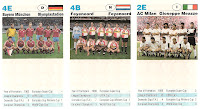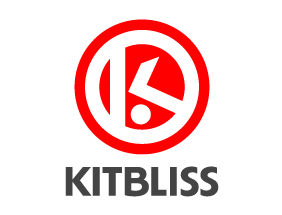For many years The Big Match served up football highlights on a weekly basis for ITV viewers in London and the south east of England. Starting in 1968, it was presented by Brian Moore - ITV's main football commentator right through to the early 1990's - ably assisted at first by Jimmy Hill and latterly by Jim Rosenthal.
Though ITV's coverage (and Moore himself) have rightly received much acclaim down the years, we thought it was time the studio sets were put under the microscope - because nothing says nostalgia more than a room painted in various shades of brown. Here's Part 1 and we pick up the action at the start of the 1968/69 season...
August 1969
Style:
1970's school staff room
1970's school staff room
Colour scheme:
A pleasing combo of blue and dark brown, divided by the warm yellow of an oak panel band.
A pleasing combo of blue and dark brown, divided by the warm yellow of an oak panel band.
Brian's desk:
Non-existent from what we can tell, but there was at least the pleasing sight of a 'Big Match' logo on the wall behind Moore using the standard ITV Sport font of the time. If you think it looks 'futuristic', remember that this was the year of the Moon landing and even a programme about football was fair game for its usage.
Guest area:
Two seats, one either side of an occasional table for glasses of water, etc. Backdrop was a funky looking wall featuring a repeating raised pattern of 'The Big Match.' Occasionally a sofa was brought out for pre-recorded inserts, plonked in front of a wall showing a nicely drawn montage of football players in action. Nice.
Gimmicks:
A large vertical panel to one side of Moore's desk displaying a similarly large still photo with a connection to the highlights package that followed. The camera would zoom in over Moore's shoulder and the image would cross-fade into Arsenal v Chelsea or some such.
Non-existent from what we can tell, but there was at least the pleasing sight of a 'Big Match' logo on the wall behind Moore using the standard ITV Sport font of the time. If you think it looks 'futuristic', remember that this was the year of the Moon landing and even a programme about football was fair game for its usage.
Guest area:
Two seats, one either side of an occasional table for glasses of water, etc. Backdrop was a funky looking wall featuring a repeating raised pattern of 'The Big Match.' Occasionally a sofa was brought out for pre-recorded inserts, plonked in front of a wall showing a nicely drawn montage of football players in action. Nice.
Gimmicks:
A large vertical panel to one side of Moore's desk displaying a similarly large still photo with a connection to the highlights package that followed. The camera would zoom in over Moore's shoulder and the image would cross-fade into Arsenal v Chelsea or some such.
 |
| August 1969 onwards: space-age fonts, groovy backdrops and big pictures. |
January 1970
Style:
Tomorrow's World meets Match of the Day.
Tomorrow's World meets Match of the Day.
Colour scheme:
Pale cyan throughout with a dash of polished steel for flashness. Also a very nice raised abstract pattern throughout much of the studio surroundings.
Pale cyan throughout with a dash of polished steel for flashness. Also a very nice raised abstract pattern throughout much of the studio surroundings.
Brian's desk:
A neat little cyan-coloured unit with clear plastic frontage trimmed with metallic strips... or grey-coloured plastic, we're not sure which. Behind the desk, a massive metallic Glam Rock-style logo which is bold, if not brassy.
Guest area:
Two modest seats, one either side of a simple occasional table on which was placed two glasses of water and, often, an empty whisky decanter.
Gimmicks:
None, other than that enormous unavoidable Glam Rock signage.
A neat little cyan-coloured unit with clear plastic frontage trimmed with metallic strips... or grey-coloured plastic, we're not sure which. Behind the desk, a massive metallic Glam Rock-style logo which is bold, if not brassy.
Guest area:
Two modest seats, one either side of a simple occasional table on which was placed two glasses of water and, often, an empty whisky decanter.
Gimmicks:
None, other than that enormous unavoidable Glam Rock signage.
 |
| January 1970 onwards: Glam rock, textured walls and empty decanters. |
January 1971
Style:
Mint choc chip.
Mint choc chip.
Colour scheme:
Green wall panels alternating with textured brown and a little bit of cafe latte thrown in for good measure. Still using a chrome-effect logo, but less 'in your face' than the last one.
Green wall panels alternating with textured brown and a little bit of cafe latte thrown in for good measure. Still using a chrome-effect logo, but less 'in your face' than the last one.
Brian's desk:
Surely the most grandiose desk Brian Moore's ever sat behind. The shape of a giant letter C, it had an oak-effect top surround with green plastic ITV Sport logos stuck on at regular intervals to face the camera. The base had that textured brown finish with a metallic 'Big Match' logo on the front. But that's not all: this desk sat in front of a revolving rear screen that rolled back to reveal a chroma-key window showing the next match coming up. Witness thus...
Guest area:
Two simple but relatively modern chairs, a circular wooden table, glasses, ashtray, etc.
Gimmicks:
Look no further than that moving rear screen. If proof were needed that The Big Match now had a bigger production budget, this was it.
Surely the most grandiose desk Brian Moore's ever sat behind. The shape of a giant letter C, it had an oak-effect top surround with green plastic ITV Sport logos stuck on at regular intervals to face the camera. The base had that textured brown finish with a metallic 'Big Match' logo on the front. But that's not all: this desk sat in front of a revolving rear screen that rolled back to reveal a chroma-key window showing the next match coming up. Witness thus...
 |
| The big reveal (l-r): Watch as the chroma-key window is revealed from the right. |
Two simple but relatively modern chairs, a circular wooden table, glasses, ashtray, etc.
Gimmicks:
Look no further than that moving rear screen. If proof were needed that The Big Match now had a bigger production budget, this was it.
 |
| January 1971 onwards: Brian's giant desk of doom, simple chairs and lots of brown. |
August 1972
Style:
Doctor's waiting room.
Doctor's waiting room.
Colour scheme:
A slightly drab two- or even three-tone green ensemble. Chrome pillars divided up the background at different points with a chrome horizontal band dividing the upper and lower parts of the green wallpaper (if wallpaper it be). Printed silhouettes of players in action occasionally appeared behind Jimmy Hill or anyone else in the guest area (see below).
Brian's desk:
A slightly drab two- or even three-tone green ensemble. Chrome pillars divided up the background at different points with a chrome horizontal band dividing the upper and lower parts of the green wallpaper (if wallpaper it be). Printed silhouettes of players in action occasionally appeared behind Jimmy Hill or anyone else in the guest area (see below).
Brian's desk:
Solid, minimalist, rounded corners and coloured using exactly the same palette as its surroundings. Behind Brian's desk were two panels, one displaying the retained metal 'Big Match' lettering, the other showing the ITV Sport logo. Clever camerawork allowed only one to be shown over Moore's shoulder if required.
Guest area:
A comfortable seat or two in purple with a simple but modern occasional table between them.
Gimmicks:
None whatsoever.
Peter Taylor distracts you from a Norwich-inspired background, Elton John's in a see of yellow and Brian Moore gets the blues...
Guest area:
A comfortable seat or two in purple with a simple but modern occasional table between them.
Gimmicks:
None whatsoever.
 |
| August 1972 onwards: Yet more chrome, wall-to-wall green and shiny pillars. |
August 1973
Style:
Cork-tastic.
Cork-tastic.
Colour scheme:
Mainly brown due to the cork-effect wall covering used extensively. Elsewhere, a red, white and navy blue combo was used for the ITV/Big Match insignia seen in front of and behind...
Brian's desk:
Mainly brown due to the cork-effect wall covering used extensively. Elsewhere, a red, white and navy blue combo was used for the ITV/Big Match insignia seen in front of and behind...
Brian's desk:
Smaller than the 1972 vintage, but smarter and more workmanlike. The programme title was displayed proudly in red with navy blue trim in front of the desk and for variation was also displayed on a sign behind Moore on the wall. Pointless, yet somehow rather pleasing too.
Guest area:
A second similarly-branded desk was provided for guests to sit behind, although the two seats were often filled by Brian Clough and Malcolm Allison (hastily drafted in to fill the gap created when Jimmy Hill hot-footed it to the BBC).
Gimmicks:
None.
Coming up in Part 2: |
| August 1973 onwards: Cork, Clough and big bold signage. |
Guest area:
A second similarly-branded desk was provided for guests to sit behind, although the two seats were often filled by Brian Clough and Malcolm Allison (hastily drafted in to fill the gap created when Jimmy Hill hot-footed it to the BBC).
Gimmicks:
None.
August 1974
Style:
Coffee and cream.
Coffee and cream.
Colour scheme:
A varied range of brown tones and white, broken up with occasional stripes and lines. A warmer golden brown was often seen on some of the wall panels, but essentially this was an unadulterated brown love-in.
Brian's desk:
A varied range of brown tones and white, broken up with occasional stripes and lines. A warmer golden brown was often seen on some of the wall panels, but essentially this was an unadulterated brown love-in.
Brian's desk:
A substantial affair with white Greek-style pillars in each corner and a solid slab of wood on top. Behind the desk on the wall above Moore's head was a sign saying TheBigMatchTheBigMatch', reminiscent of the type used the previous season. So good they named it twice, you might say.
Guest area:
Last season's guest desk had been taken away (probably now sitting in Nigel Clough's garage). Instead, we now had the altogether more informal arrangement of two brown leather swivel chairs for guests to sit on (as amply shown by Rodney Marsh and Terry Venables on the Christmas 1974 show).
Gimmicks:
A reveal! Yes, if you thought The Generation Game had the copyright on sliding doors, think again. Over Brian's shoulder, a screen painted with a generic football action scene would open up to reveal a chroma-key portal looking out onto Loftus Road or some other footballing mecca in the capital (see below).
 |
| August 1974 onwards: Stripes, a multitude of brown and repetitive wording. |
Last season's guest desk had been taken away (probably now sitting in Nigel Clough's garage). Instead, we now had the altogether more informal arrangement of two brown leather swivel chairs for guests to sit on (as amply shown by Rodney Marsh and Terry Venables on the Christmas 1974 show).
Gimmicks:
A reveal! Yes, if you thought The Generation Game had the copyright on sliding doors, think again. Over Brian's shoulder, a screen painted with a generic football action scene would open up to reveal a chroma-key portal looking out onto Loftus Road or some other footballing mecca in the capital (see below).
 |
| Can you tell what it is yet? (l-r): The screens pull back to reveal a shot of the Tottenham badge at White Hart Lane. |
Peter Taylor distracts you from a Norwich-inspired background, Elton John's in a see of yellow and Brian Moore gets the blues...




























